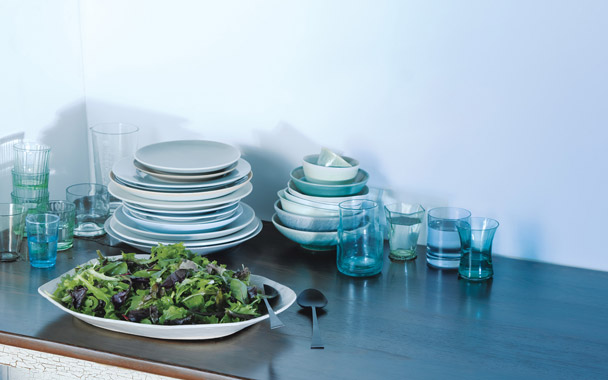There was an epoch in my life when I lived in Manhattan in a tiny fourth-floor walk-up with one small closet and two windows. In any other city, an apartment like that would have been considered dark and cramped, but in the soap bubble I then inhabited, full of wishes, it was looked on by my friends as covetable and charming. The kitchen contained an under-the-counter icebox; an ancient four-burner gas stove, no bigger than one in a play kitchen; and precisely three pans—a white enamel stockpot, a ten-inch cast-iron skillet, and an eight-inch copper saucepan, given to me on my 18th birthday by an aunt with a knack for prophetic gifts. An immense table took up half the space. It was surrounded by eight chairs.
Somewhere between taking leave of my childhood and kick-starting what I then thought of as “real life,” I discovered that I loved to cook. Not just to cook, but to feed people, preferably a lot of people, all at once. Looking back, I’m not sure that this mania hasn’t determined, if not the course of my life, then a series of variegated dinners—slapdash, elegant, unpremeditated, planned—that teeter between mishap and mayhem.
My culinary career, like my mother’s, did not begin auspiciously. The first time she roasted a chicken (when still newly wed), she left the plastic bag of guts inside. Following this incident, my mother, who believes a job worth doing is worth doing well, turned herself into an admirable cook by attending adult-education classes, given by the indomitable Libby Hillman, whose cookbook, Lessons in Gourmet Cooking, remains a trusty guide in my kitchen, treasured for its cheering asides (“Sit down and have dinner with your guests”) and foolproof chocolate roulade. As a result, my mother could turn out—as could her friends—endless rounds of boeuf bourguignon, coq au vin, and something called pots de crème, for which she bought tiny porcelain cups painted with plums.
On the nights of these parties, the doorbell rang; the women arrived in silk shantung and pearls. The transformation of my mother and her friends from carpool moms to chain-smoking sylphs bewildered and thrilled me. This, I thought, was life. Enraptured, I (in my flannel nightgown) passed hors d’oeuvres: celery sticks filled with cream cheese and pigs in a blanket that my mother made in batches and froze in her basement freezer.
That was dinner-party food. For my brother and sister and me, my mother cooked baked chicken and mashed potatoes, flounder fillets dipped in egg and flour and fried, and macaroni and cheese. I don’t remember her ever requesting “help.” When I left for college, my repertoire consisted of tuna melts on Thomas’ English Muffins, Toll House cookies, and a weird combination, taught to me by my grandmother, a slouch in the kitchen, of equal parts Campbell’s cream of mushroom soup and cream of chicken soup, with a shot of Dry Sack.
In college, after a year of dormitory food, I moved off campus to a ramshackle house where the refrigerator, when I arrived, mirrored the holdings of the nearby Museum of Comparative Zoology. On the back of the ancient stove bubbled a stockpot, continually topped up by a thrifty roommate who had read somewhere that anything could and should be thrown into soup: The stock heaved with toast crumbs, orange juice, and lemon peels. Another roommate, a diminutive girl who had grown up in Brooklyn in a house where Marilyn Monroe had once lived and who had been to Italy after her sophomore year, made tomato sauce out of canned San Marzano tomatoes from the supermarket up the street. It was cheap, filling, and delicious. (She added a pinch of sugar.) Feeding two, then four, then eight grateful pals at the rickety table, she turned the kitchen, with its peeling red and black floor, from a dank alchemist’s cave into a haven. I was hooked.
Hooked, but not yet cooking. It took a summer in France, during which I was so poor I don’t remember eating a meal in a restaurant. Instead I spent my small cache of francs at the boulangerie and the charcuterie and blissfully bit into cold roast veal inside a slashed baguette. One day I plucked a secondhand copy of Elizabeth David’s French Provincial Cooking from the English kiosk at a bookstore in Grenoble. I read it straight through. By the time I got to the chapter on “Sweet Dishes” and read “Nearly everyone knows … the formula for a chocolate mousse” (I did not), I had decided that that was the “everyone” I wanted to be.
By the time I moved to New York, I was cooking tendrons de veau Marengo (veal breast was cheap). I made chocolate mousse in vats, and St.-Émilion, that lovely cake made with ganache and Italian macaroons, and afterwards we lit the cookie wrappers and they curled up in blue fizz.
Like attracts like. My husband grew up in a family of ten child-ren, where the motto was “There are two kinds of people—the quick and the hungry.” From the epoch that began with a tiny kitchen, three pans, and a big table, I emerged with four children, a batterie de cuisine, and a dining room table that seats 16. To my spouse, anything less than six at the table is tantamount to solitary confinement. Between us, we have 27 nieces and nephews. Often I have addressed the immortal words “We’re only ten for dinner” to the butcher. To me, it is a legendary phrase first uttered by my friend Elspeth (who grew up as one of six and is now also a mother of four) one busy Christmas week after a portion of her family, roommates in tow, kept returning from long bracing walks, ravenous and looking for something—anything—to eat.



 Pinterest
Pinterest






